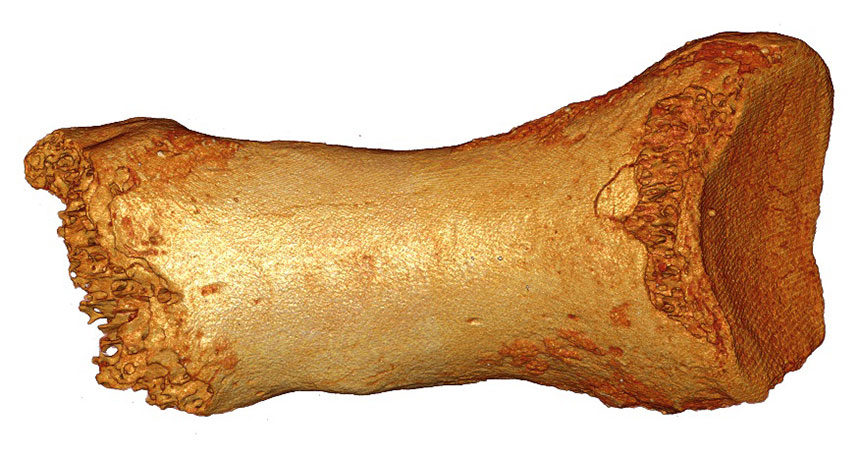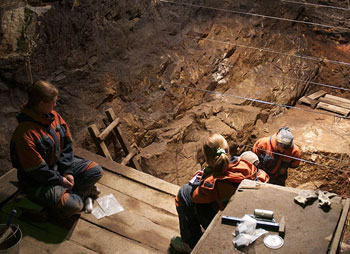Neandertal toe contains human DNA
Analyses show humans and Neandertals mixed and mated far earlier than previously thought

This 50,000-year-old bone from the toe of a Neandertal woman was found in a cave in Siberia. It contains human DNA.
Bence Viola
Humans and Neandertals may have hooked up much earlier than previously thought.
Neandertals — Homo neanderthalensis — are ancient members of the human family tree. New evidence has just turned up early ancestors of humans in Africa mated with Neandertals about 110,000 years ago. The clue to that mixing is in the DNA of a Neandertal woman in Siberia, Russia.
Many humans today carry bits of Neandertal DNA. DNA is a chemical that makes up genes. Genes provide instructions for building bodies. This is the first time human DNA has been found mixed in with a Neandertal’s genes. The team reported its findings online February 17 in Nature.
If the finding is correct, it shows that the link between humans and Neandertals is older and more complicated than scientists had assumed, says Sarah Tishkoff. She works at the University of Pennsylvania in Philadelphia, where she was not involved in the new study. As an evolutionary geneticist, she studies how genes have changed over thousands or millions of years.

Until now, scientists were puzzled about why they hadn’t found signs of human-Neandertal mixing in Neandertal genes, says Graham Coop. He’s an evolutionary geneticist at the University of California, Davis. The new finding seems to confirm now that DNA traveled both ways, he says.
The new study was led by Adam Siepel. He’s a computational biologist at Cold Spring Harbor Laboratory in New York. He and his coworkers analyzed the DNA from a toe bone of a 50,000-year-old Neandertal woman. About 1 percent to 7.1 percent of her DNA contained traces of human DNA, they found. The toe bone had turned up in a Russian cave in the Altai Mountains of Siberia. It’s the same cave where the only known fossils of extinct human cousins, called Denisovans, had been found. Denisovans also mated with humans in Asia and with Neandertals.

The Altai woman shared more DNA with modern humans than she did with the two European Neandertals. That suggests early humans mated with the Altai Neandertal’s ancestors. But the ancestors of the European Neandertals didn’t mix with humans much, if at all, Siepel concludes.
The European and Altai Neandertals had a common ancestor. The groups went their separate ways between 68,000 and 167,000 years ago. The new study shows that early humans must have left their DNA in the Altai genetic instruction manual after that split. The scientists estimate that happened some 110,000 years ago.
Seipel doesn’t know where the mixing happened. Neandertals never lived in Africa. That means the humans must have come out of Africa and met up with Neandertals somewhere else.
Siepel says the new findings may force scientists to rethink some ideas about when humans first migrated out of Africa. The leading idea has been that this happened some 50,000 to 60,000 years ago. But, he adds, the new finding “points fairly strongly to an earlier migration.”
Power Words
(for more about Power Words, click here)
chromosome A single threadlike piece of coiled DNA found in a cell’s nucleus. A chromosome is generally X-shaped in animals and plants. Some segments of DNA in a chromosome are genes. Other segments of DNA in a chromosome are landing pads for proteins. The function of other segments of DNA in chromosomes is still not fully understood by scientists.
computational genetics A field in which scientists use mathematics and computer programs to better understand genetics.
Denisovans An ancient humanlike population whose existence is known only because of a few fossils discovered in a cave in Siberia.
DNA (short for deoxyribonucleic acid) A long, double-stranded and spiral-shaped molecule inside most living cells that carries genetic instructions. It is built on a backbone of phosphorus, oxygen, and carbon atoms.In all living things, from plants and animals to microbes, these instructions tell cells which molecules to make.
evolution A process by which species undergo changes over time, usually through genetic variation and natural selection. These changes usually result in a new type of organism better suited for its environment than the earlier type. The newer type is not necessarily more “advanced,” just better adapted to the conditions in which it developed.
evolutionary genetics A field of biology that focuses on how genes — and the traits they lead to — change over long periods of time (potentially over millennia or more). People who work in this field are known as evolutionary geneticists.
gene (adj. genetic) A segment of DNA that codes, or holds instructions, for producing a protein. Offspring inherit genes from their parents. Genes influence how an organism looks and behaves.
genetic Having to do with chromosomes, DNA and the genes contained within DNA. The field of science dealing with these biological instructions is known as genetics. People who work in this field are geneticists.
genome The complete set of genes or genetic material in a cell or an organism. The study of this genetic inheritance housed within cells is known as genomics.
migration (v: to migrate) Movement from one region or habitat to another, especially regularly and according to the seasons. One that makes this move is known as a migrant.
Neandertal A species (Homo neanderthalensis) that lived in Europe and parts of Asia from about 200,000 years ago to roughly 28,000 years ago.
Siberia A region in northern Asia, almost all of which falls within Russia. This land takes its name from thelanguage of the Tatar people, where Siber means sleeping land. This region is vast. It has become famous for its long, harsh winters, where temperatures can fall to −68° Celsius (−90° Fahrenheit).







